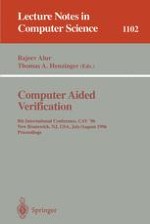This book constitutes the refereed proceedings of the 8th International Conference on Computer Aided Verification, CAV '96, held in New Brunswick, NJ, USA, in July/August 1996 as part of the FLoC '96 federated conference.
The volume presents 32 revised full research contributions selected from a total of 93 submissions; also included are 20 carefully selected descriptions of tools and case studies. The set of papers reports the state-of-the-art of the theory and practice of computer assisted formal analysis methods for software and hardware systems; a certain emphasis is placed on verification tools and the algorithms and techniques that are needed for their implementation.
